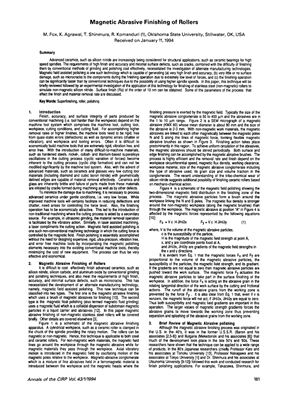Статья. Опубликована в журнале "CIRP Annals - Manufacturing
Technology. – 1994. – Vol. 43, Is.1 – P. 181-184.
Авторы: M. Fox, K. Agrawal, T. Shinmura, R. Komanduri.
Статья на английском языке.
Название на русском языке: Магнитно-абразивная обработка роликов.
Аннотация к статье на английском языке:
Advanced ceramics, such as silicon nitride are increasingly being considered for structural applications, such as ceramic bearings for high speed spindles. The requirements of high finish and accuracy and minimal surface defects, such as cracks, combined with the difficulty of finishing them by conventional methods of grinding and polishing cost effectively, necessitated the investigation of alteate manufacturing technologies. Magnetic field assisted polishing is one such technology which is capable of generating (a) very high finish and accuracy, (b) very little or no surface damage, such as microcracks to the components during the finishing operation due to extremely low level of forces, and (c) the finishing operation can be significantly faster than by conventional techniques due to the possibility of using higher spindle speeds. In this paper, this technique will be briefly reviewed followed by an experimental investigation of the application of this technology for finishing of stainless steel (non-magnetic) rollers to simulate non-magnetic silicon nitride. Surface finish (Ra) of the order of 10 nm can be obtained. Some of the parameters of the process that effect the finish and material removal rate are discussed.
Advanced ceramics, such as silicon nitride are increasingly being considered for structural applications, such as ceramic bearings for high speed spindles. The requirements of high finish and accuracy and minimal surface defects, such as cracks, combined with the difficulty of finishing them by conventional methods of grinding and polishing cost effectively, necessitated the investigation of alteate manufacturing technologies. Magnetic field assisted polishing is one such technology which is capable of generating (a) very high finish and accuracy, (b) very little or no surface damage, such as microcracks to the components during the finishing operation due to extremely low level of forces, and (c) the finishing operation can be significantly faster than by conventional techniques due to the possibility of using higher spindle speeds. In this paper, this technique will be briefly reviewed followed by an experimental investigation of the application of this technology for finishing of stainless steel (non-magnetic) rollers to simulate non-magnetic silicon nitride. Surface finish (Ra) of the order of 10 nm can be obtained. Some of the parameters of the process that effect the finish and material removal rate are discussed.

